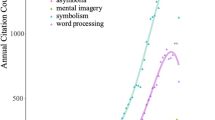Abstract
In a study designed to identify the determinants of accurate self-referent behavior, Ss predicted their individual performances on arithmetic and clerical tasks and indicated self-descriptive traits and roles on the Adjective Check List and the Twenty Statements Test. Traits and roles characterizing accurate or inaccurate predictors were then presented to additional Ss before they predicted their scores on the same taks. As hypothesized, the self-ascription of traits and roles associated with baseline accuracy increased predictive accuracy, and inaccurate ascriptions decreased accuracy. The findings are consistent with Mead’s symbolic interactionist approach of self-referent action and suggest that the experimental analysis of behavior may shed further light on the antecedents of accurate self-prediction and self-control.
Similar content being viewed by others
References
ARONSON, E. & CARLSMITH, J. 1968. Experimentation in social psychology. In G. Lindzey & E. Aronson (Eds.) Handbook of social psychology. Vol. II. Reading, Mass.: Addison-Wesley.
BEM, D. J. 1965. An experimental analysis of self-persuasion. Journal of Experimental Social Psychology, 1, 199–218.
BEM, D. J. 1967. Self-perception: An alternative interpretation of cognitive dissonance phenomena. Psychological Review, 74, 183–200.
FREEDMAN, J. L. 1969 Role playing: Psychology by consensus. Journal of Personality and Social Psychology, 13, 107–114.
GOUGH, H. G. 1952. The adjective check list. Palo Alto, Calif.: Consulting Psychologists Press.
KUHN, M. H., & MCPARTLAND, T. S. 1954. An empirical investigation of self-attitudes. American Sociological Review, 19, 68–76.
MEAD, G. H. 1934. Mind, self and society. Chicago: University of Chicago Press.
MIXON, D. 1971. Behavioural analysis treating subjects as actors rather than organisms. Journal for the Theory of Social Behaviour, 1, 19–31.
RYLE, G. 1949. The concept of mind. London: Hutchinson.
TOUHEY, J. C. 1971. A symbolic interactionist approach to self-referent behavior. Psychological Reports, 29, 87–90.
TOUHEY, J. C. 1972. Studies in symbolic interaction: I. Conversion of controlling stimuli. The Psychological Record, 22, 125–131.
Author information
Authors and Affiliations
Additional information
The present investigation was supported by a faculty research grant from the Research Office of the University of Tulsa. The author would like to thank Catherine Gunderson for assistance with collection, coding, and judgment of the data.
Rights and permissions
About this article
Cite this article
Touhey, J.C. Studies in Symbolic Interaction: II. An Experimental Analysis of Self-Referent Behavior. Psychol Rec 22, 325–331 (1972). https://doi.org/10.1007/BF03394097
Published:
Issue Date:
DOI: https://doi.org/10.1007/BF03394097




